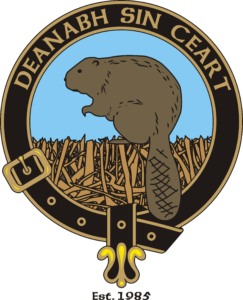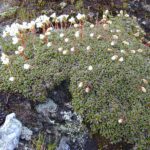Hiking Above Treeline: Coloring Inside the Lines
By Wes Tucker
I once saw a book titled, All I Really Need to Know I Learned in Kindergarten. The same thing could be said about hiking above treeline, because it’s all about staying inside the lines and connecting the dots. I’m sure most of you are aware that as you climb higher up in our mountains, the trees get shorter and shorter, then disappear entirely. It’s that region where the trees dare not grow that is the subject today.
When you leave the trees below, it can seem like you’re entering an alien world. And in a sense, you are. It's not a world alien to our planet, but alien to our latitude. Most researchers agree that ecosystems found on our higher summits are remnants of how things looked about 10,000 years ago. As the mile high ice age glaciers retreated from our environs, they deposited seeds that they picked up in arctic Canada. These plants flourished in the cold, scoured rock landscape left behind. Heck, it was just like back home! But alas, it would not endure. As the climate warmed, plants from the south that were spared by the glaciers moved north, and pushed the arctic vegetation up into the highest elevations. It was here that they finally found a home where they could survive, and the larger competing plants couldn’t. This is what we now call the alpine zone. It is here that generations of alpine flora have survived and thrived, isolated on their islands in the sky.
My personal favorite alpine plant is the diapensia (pictured). Granted, the name doesn’t roll off the tongue. It’s easier if you remember it as the “Diet Pepsi” plant. Diapensia is one tough customer. It grows in densely packed mounds usually 10-24 inches around. Their tiny leaves are thick and waxy to conserve moisture. They pack tightly together to form a nearly solid aerodynamic mound that sheds the howling winds. But the masterstroke is that they contain a special pigment that absorbs UV radiation and converts it to heat. With this built in furnace, they can extend their growing season by melting the snow around them in the spring. This gives them an edge over other alpine plants and is one of the first to bloom each year. Each June, delicate white flowers extend about an inch above the mound to wave in the breeze. But life in the alpine zone is hard and slow. The growing season is incredibly short; only 6 weeks or so. Consequently, the plants take an incredibly long time to grow. A mound of diapensia about the size of a dinner plate is probably 60 years old.
Diapensia is not particularly rare as alpine plants go. But there are many other plants that are extremely rare. Some only exist in the White Mountains. Probably the most famous is Robbins' Cinquefoil, a tiny flower found only on the Presidential Range and Franconia Ridge. Great efforts have been expended to ensure its survival. Not the least of which was to relocate a section of the historic Crawford Path to protect a colony. Thanks to these efforts in the 1980's and 90's, along with the cooperation of the hiking community, the plant was removed from the endangered species list in 2002.
This brings me to what this article is supposed to be about after all; hiking above treeline. It's plants like diapensia and dwarf cinquefoil that make this environment so wonderful and unique. So why would we want to damage what makes it so special by being careless? I think the ancient philosopher Spike Jones put it best when he sang, “You always hurt the one you love.” Over millennia, alpine plants have adapted to screaming winds and killer cold. But as tough as they are, they haven’t had that same luxury of time to adapt to the crush of a lug soled boot. As I said before, the alpine growing season is exceedingly short. One careless step could undo decades of growth. And it seems that the main source of damage is hikers who have trouble staying on the trails.
In our above treeline areas, we as a society have decided to sacrifice narrow ribbons of land to use as hiking trails. They allow us access to these wonderful regions, while restricting our impact to the trail treadways. But for this to work, we hikers have to fulfill our side of the bargain by staying on the trails. That can be a lot to ask of someone in this phenomenal landscape. You might feel like you’re in The Sound of Music, but please suppress the urge to go running and twirling across the alpine fields (you can still sing if you want). In the European Alps, you can actually do that because they’ve been grazing cattle there for centuries. Our “alpine” areas are quite different. So the key to protecting them is to STAY ON THE TRAIL.
When hiking at lower elevations, it’s usually pretty obvious when you’ve strayed from the trail because of all the trees. But above treeline, it’s quite easy to stray from the treadways if you don’t pay close attention. Trail maintainers have done their best to make it clear where trails are, but there is only so much they can do. Their primary tools are scree walls and cairns. Scree is just a fancy word for small rocks. When the trail edges are lined with low walls of scree, it defines the trail without being intrusive. A cairn is a fancy word for mounds of rocks. They range from basic 1 foot piles, to intricately constructed 7 footers. They’re used to mark the trail and are placed at regular intervals to help you find it even in low visibility.
So like I said before, it’s all about staying inside the lines and connecting the dots. If you just hike between the lines of the scree walls, and connect the dots made by the cairns, that’s all we ask. It’s a pretty simple in concept, but not so simple in practice. Without regular maintenance, scree walls get kicked out of place and lose effectiveness. Even when in perfect condition, hikers who don’t understand their purpose will still step over them and wander off-trail. Cairns are a bit hardier, but can still be dismantled by the ignorant. So for it to work, the system relies on the cooperation of informed hikers… like you.
This doesn’t mean that you’re a prisoner of the trails. Of course there will be times that you will need to step off them; to let other hikers pass, or to get that perfect photo. In these cases, your rule should be to only walk on the rocks so you’ll be less likely to disturb the vegetation. This should be done as little as possible and be careful to limit your steps only to rocks. Even walking on unvegetated soil should be avoided. This rock hopping can be a bit tricky. The lichen covered rocks off-trail can be very slippery and unstable.
Our above treeline zones are rare, wonderful, and sometimes otherworldly places. They can both inspire and challenge us. But when we visit them, great care must be taken to keep them the way they are. If we want to ensure that they remain inspiring and challenging for generations to come, we all need to stay between the lines and connect the dots.


This article is as full of good information as it is of wit, and Wes is quite witty here. Of course, we tend trails in an “alpine” zone on Mt Firescrew and Mt Cardigan, but the message here applies even more to other places we like to hike. On most treeless hills we can wander the tundra at will, because we hardly leave a trace on it. Alas, soon enough a hundred and then a thousand follow the same desire lines heading for the same places. Soon we have worn a path into the landscape. Before long the factors of downpours or just a moist climate, steeper gradients, wind, and regular trampling by knobby-soled boots result in deepening erosion on what was a healthy community of grasses, mosses, and other plants that can live up there… but I start to repeat the fine article above.
We do ourselves as well as our alpine neighbors a favor if we just read and heed it.